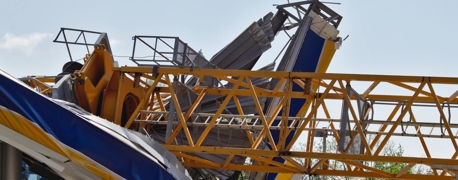Louisiana Workers & Grain Entrapment Risks

It’s one thing to work in a grain bin when it’s empty. There are significant fall risks, as well as the normal dangers of working with heavy machinery. But when the silo is packed full of grain, terrifying grain entrapment accidents become possible.
Asphyxiating in grain sounds like a scenario out of a horror movie, but hundreds of these incidents have been recorded since 1964. The number of entrapment and engulfment accidents has risen steadily every decade since then, and below are just a couple recent examples of that grim fact.
On September 18, 2018, a worker was performing maintenance around a silo in Pointe Coupee Parish, and the container was filled up to 50 feet high with soybeans. Around 4pm, the man fell in and was quickly swallowed up by the soybeans. It wasn’t until more than three hours after that the worker’s body was recovered. The recovery efforts were slowed down by the fact that it was hot, and there was lots of severely flammable dust in the bin. Even with the precautions taken, one of the rescuers almost fell into the soybeans himself.
February 14 of 2024, a worker in his late fifties was found dead in a grain storage bin in the Bayou Rouge area. Once emergency responders arrived, it still took them several hours to remove the body. One of the firefighters on the scene noted that there aren’t regulations or training for workers around silos, nor was there grain bin rescue training provided for workers or even for firefighters.
Louisiana Grain Workers Face a Host of Risks: Entrapment Is the Deadliest
Some of the ever-present risks that workers face in and around grain bins include:
- Fires and explosions from airborne grain dust
- Falls from heights, both inside and outside these large structures, whether on platforms, lifts, ladders, etc.
- Machinery and equipment accidents
- Breathing in mold and other toxic particles (from spoiled grain)
- Grain entrapment and engulfment
Thought it is far from the only fatal risk that grain workers run, suffocation is the leading cause of death for workers in grain storage.
According to Purdue University data on grain entrapment accidents:
- More than 900 grain entrapments have occurred since 1964 (though the number may be much higher, since many non-fatal entrapments don’t get reported).
- More than 60% of these entrapments were deadly—at least 498 people have suffocated.
- Of the nearly 1,000 people that have been in entrapment accidents, approximately 200 of them were younger than 18 years old, kids who by law should never have been given such dangerous jobs.
Again, these numbers haven’t declined since the sixties. In 2020, there were 64 suffocation incidents involving grain entrapment, at least 33 of which were fatal. In 2022, there were 42 grain entrapment accidents with 15 of these reported as deadly. To compare, that same year there were 9 explosions reported with some injuries, but no fatalities.
Grain Bins vs. Silos in Louisiana
A note on terminology: the terms grain bins and silos can be used interchangeably in informal discussions, but technically speaking, the two structures are very different. The silos you can spot on a dairy farm are usually tall, narrow, and made of concrete or steel, or sometimes wood or bricks. They have a domed roof, and they need to be airtight to store wet fodder, such as grass, to feed dairy cows.
Grain bins on the other hand store dry corn, soybeans, oats, barley, wheat, and so forth. They might be tall structures, but they’re often wide as well, made of corrugated steel (so they’re shinier), and they have peaked roofs as well as stairs or ladders. These structures can still be used for animal feed, but they also hold dry grain for domestic food and food exports. Keeping this grain dry is crucial for preventing grain spoilage as well as reducing hazards for workers.
How Do Grain Bin Accidents Happen?
Grain bins can easily store tens of thousands of bushels of grain (a U.S. bushel is about 35 liters, or 9.3 gallons), so if a worker falls in, even if their head is above the grain, the pressure leaves them unable to move, and sometimes unable to breathe.
Anyone working in or around grain bin can fall in, whether it’s from a catwalk, platform, or lift, but some of the highest risks for engulfment happen while a worker is checking on grain that isn’t flowing properly into an unloading machine, or while they’re gathering a sample to check for moisture, humidity, and other measures of quality. While these risks apply to workers who are in the grain storage bins that you can spot from the highway, they also occur in grain storage on semi-trailers, grain wagons, and other transports.
Working in Flowing Grain
When grain is in motion, it’s like quicksand or at times even water. You have nothing to push against and you can quickly get sucked in. For instance, when equipment at the bottom of a storage bin is unloading the grain, this creates a funnel. Anyone who is inside the bin while grain is flowing can sink knee-deep into the grain in just 4 seconds; if you’re in this deep, you can’t pull yourself out because of the suction. In 20 seconds or even less, you can be completely submerged in grain.
A worker might be inside the bin, looking for clumps of spoiled grain that need to be broken up, while someone outside might be unaware of this and turn on equipment. As the grain starts flowing out the bottom of the bin, within seconds, the worker can be sucked down and completely engulfed by grain, pinned down by the pressure and unable to move. At other times, a worker operating a grain vacuum while inside the bin can get sucked in or fall into the flow of grain, quickly becoming engulfed.
Employers need to ensure that lockout/tagout procedures are carefully followed, that there’s adequate communication between all workers, and that no one works in a grain bin alone. Workers inside the bin should always be equipped with harnessed attached to safety lines as well.
Working on Grain Bridges
Another risk is that of grain bridges collapsing under you. When grain spoils, whether it’s moldy, frozen, or crusted over for some other reason, there’s often an air pocket beneath this “bridge”. If a worker walks on the grain with a shovel or picks to break up this bit of grain, a whole section can break off under them, causing them to plummet and land in grain that quickly buries them.
While workers inside grain bins should always be harnessed and connected to a safety line, even then they shouldn’t be told to go out onto a grain bridge to break it up—walking down grain is illegal. Instead, while harnessed to a safety line, a worker should be provided with a long pole, bin whip, or a similar tool to use while perched on a ladder or some other secure mount, their feet in no way resting on the grain.
Working Near Vertical Walls of Grain
Even when a grain bin is only partially filled, engulfment risks remain. If a worker inside the bin is by a vertical wall of grain, possible when a tall pile of grain has crusted over, all it can take is shifting some grain at the bottom of the pile or a vehicle rumbling by to shake this wall loose and trigger an avalanche inside the bin.
With grain bridges and vertical walls alike, this type of grain caking can be prevented by keeping the grain from spoiling—also the responsibility of the employer. With the right structural design, maintenance, and technology, grain bins can stay in good repair, keep moisture out, and be equipped with ways to remotely monitor moisture, humidity, and other key factors.
Can Workers Trapped in Grain Be Rescued in Time?
The odds are slim, but yes, it can be done. If a worker doesn’t get completely submerged at any point, then prompt and strategic rescue efforts can be successful. The problem is that partial entrapment cases can quickly turn into the victim being completely dragged down, deep under the grain. If someone is entirely engulfed, it’s almost impossible to get them out in time. Even so, there have been cases where people who were totally submerged in grain, and they had pockets of air and respiratory masks that kept them alive for a couple of hours, enough time to be rescued.
How Do You Rescue Someone Who Is Partially Entrapped in Grain?
If you’re both in the grain bin, and one of you gets sucked in, if you move towards them to try to pull them out, the additional motion can cause them to sink further while getting pulled in yourself. If the person is wearing a harness and gets sucked in up to their waist, it would take at least 600 pounds of force to pull them out. Instead of trying to move toward the victim or pull them out, the first step is to use a ladder, wooden planks, crates, whatever is available to help with weight distribution, while also using something to protect the person’s head from getting buried. This could be something like a bucket or trash can with the bottom cut out, something that can act like a retaining wall around the person to keep the grain from burying them further. Then the goal is to scoop or siphon off the grain around the trapped person until they’re free enough to pull out.
There are grain bin rescue tubes built for this exact purpose. These are metal plates that you can place around the trapped person to form a tube around them, and there are usually handles on either side for the trapped person to eventually climb out of and to help rescuers. An augur built for that tube can then start draining grain from the tube directly, helping to speed up rescue efforts.
Of the 25 grain bin rescue tubes available in Louisiana, 17 of them are at fire stations. That’s 25 rescue tubes for all sixty four parishes. Of the parishes with the most grain bins (St. James, St. John the Baptist, and St. Charles), only St. James has a rescue tube and augur located in the region.
Throughout this tense process, rescuers have to take every precaution, as they themselves can easily get sucked in and buried. This includes rescuers being harnessed to safety lines and wearing masks themselves. Even in cases where someone is partially submerged, rescue efforts can take hours, even when someone was able to call 911 immediately.
What Can You Do If Someone Is Entirely Trapped in Grain?
If someone is completely engulfed by grain, it would take more than 2,000 pounds of force to pull them out. Even if you could somehow do this, it would still kill the victim. You would have to find them first too. Grain moves quickly, and when someone vanishes from sight, they can be dragged down and far away from the spot where they last were seen.
The first step can be turning off any equipment that was causing the grain to flow and calling 911. The next step is usually to cut holes in the bin to let it drain enough for you to get to the victim’s head, with the goal of placing some sort of structure around them to protect them from being re-submerged. This means cutting as close as you can to a spot below the trapped person’s feet, and it’s probably going to just be your best guess as to the location. At minimum this will require cutting two holes on opposite sides of the bin, though ideally there will be at least four carefully spaced out U-or V-shaped holes, about 35 inches across, to let the grain out without the bin collapsing. Since the cuts will be made in sections where there’s grain and not air, it’s safe to do with a power saw or even a cutting torch, but care is always required.
As the grain drains outside, you also have to keep it from accumulating too high and creating new risks. The grain has to be moved away and people kept out of its vicinity. If the trapped person can be rescued from the grain, then they’ll quickly need a self-contained breathing apparatus or any oxygen mask, an IV to help stabilize their body temperature, and of course to get whisked off to the hospital.
It’s a massive effort that requires a lot of manpower and persistence, and too often, everyone behind this effort knows that they’re working on a recovery job, not a rescue. It can take eight minutes or less for someone to suffocate. Even so, there are multiple cases where people were buried for up to two hours and still survived the ordeal.
The Best Type of Rescue Is the One That Isn’t Needed: Louisiana Employers Can Prevent Grain Entrapment Accidents
As easy as it is to get sucked in and fall down, it’s heartbreakingly difficult to get out, and you can’t get out alone. While rescue is possible, the best way Louisiana employers can keep workers safe is to prevent these grain entrapment accidents from happening.
Some of the basic ways to do this includes ensuring that:
- Storage containers are in good shape to prevent grain spoilage
- Workers are provided with safety equipment and training
- Work is conducted legally
Avoiding Poor-Quality Grain
Workers most often get sent into bins to look for and deal with spoiled grain. It really shouldn’t come to this though. Farms and companies can invest in technology to remotely monitor moisture and temperature in grain bins, and with sound bin construction and maintenance, you can prevent grain from clumping up, whether due to mold, pests, or inclement weather. There shouldn’t be a need to send someone in to collect a grain sample or to disperse crusted grain.
Providing Grain Workers with Adequate Safety Equipment, Procedures & Rescue Training
Even if grain does need to be broken up in order to unload it for transport or some other purpose, it’s only too common for workers to not take the threat of engulfment seriously. In some cases, this may be because a seasoned farmer feels that they can go check on a problem by themselves really quickly, and they may have done so hundreds of times before without incident.
Typically, however, workers who get sent to perform work inside grain bins are inexperienced in that line of work. Therefore, employers can more easily get away with failing to provide basic training to these workers, who are not aware of the dangers they face and haven’t been told what their rights are, what safety measures to take, and how much gear their employer is supposed to provide for them.
This also means that workers are unaware that their employer is breaking the law—and risking their lives to do so—when they’re sent in a bin to walk down grain.
No employer should be sending someone in with a shovel or other tool to walk on the grain, for any reason. The risk of falling through a grain bridge is too high. While work might still need to be done inside the bin, workers should be provided with thorough safety and rescue training as well as the mask, safety harness and lines, and long tools they need to break up the grain without setting foot on the grain. Workers also shouldn’t be performing tasks in or around a grain bin alone. The responsibility for all this, ensuring that all safety measures are known and upheld, falls to the employer.
Who Regulates Louisiana Farms & Grain Handling Facilities?
The majority of grain entrapment accidents occur on smaller, OSHA-exempt farms.
While there are guidelines for grain handling safety, and OSHA used to have an inspection rotation for certain facilities, there isn’t much in the way of current regulations or enforcement when it comes to grain bin safety. Even in cases where OSHA does have jurisdiction and has responded to cases of injury or death in grain bins with heavy fines, these fines tend to get cut down by almost half or more. What measures there are rather weak when it comes to forcing employers to take basic care of their workers.
Louisiana Grain Companies & Employers Need to Do More for Worker Safety
Louisiana is one of the nation’s largest exporters in general, and that applies to grain as well. Just under half of America’s grain exports goes through Louisiana ports, with soybeans being the biggest grain export. While as of March 2024, the amount of grain stored in Louisiana was lower than usual, there were still 5.85 million bushels of soybean, 4.55 million bushels of wheat, and 19.6 million bushels of corn stored in the state. This means millions of bushels of grain are transported throughout Louisiana, often by barge, railway, and trucks.
The need for storing grain and moving grain from those storage bins is not going away any time soon. Yet across the Midwest as well as Louisiana, there is a pattern of employers getting away with risking their workers’ safety in order to save time and money instead of investing in safer operations.
Unfortunately, this current pattern has been true for decades, and the underlying motivation hasn’t gone away. Professor William Field of Purdue University worked on the entrapment data mentioned at the start, and he has monitored and analyzed grain entrapment accidents since 1978, even consulting OSHA on these issues. Referring to why managers and employers still choose to send workers into terrifying, hazardous work, he said, “The bottom line is if you ask them why they did it, it was because it was more profitable to do it that way.”


